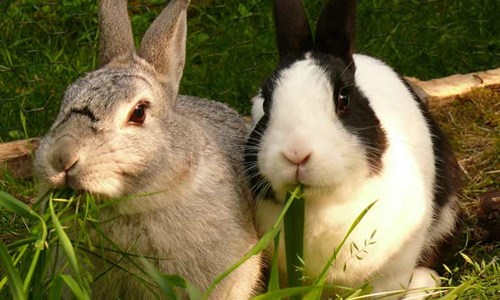Housing pet rabbits in pairs or compatible groups
What's the issue?
Companionship is extremely important for the health and welfare of pet rabbits.
Traditionally, rabbits are prey animals that live in colonies in the wild for ‘safety in numbers’. This social instinct is still present in pet rabbits today.
Evidence shows that pet rabbits greatly benefit from living with other pet rabbits, with companionship having a positive effect on their health, behaviour, emotional wellbeing, and regulation of body temperature.
However, according to the 2019 PDSA Animal Wellbeing (PAW) report, 49% of rabbits in the UK still live alone with no companionship
What's our view?
Pet rabbits should be housed in compatible pairs or groups, and they shouldn’t be housed with guinea pigs. As much space as possible should be provided for pet rabbit housing and enclosure, both indoors and outdoors.
We recommend:
- Where pet rabbits of the opposite sex are kept in pairs or groups, both rabbits should be neutered. However, as neutering is not a trivial procedure, we would advise that owners discuss the health and welfare benefits and risks for the individual animal in question with their vet.
- Same-sex pairing of pet rabbits should consist of siblings or two rabbits taken from different litters that are both between 8-10 weeks old to avoid fighting. Ideally same-sex pairs should never be separated. We would advise that same-sex pairing of rabbits should be undertaken with expert veterinary advice as there is more potential for serious fighting than when introducing opposite sex pairs.
- Pet rabbits should not be housed with guinea pigs. Guinea pigs have different dietary needs to rabbits, are smaller and less powerful than rabbits and are at risk of injury. In addition, guinea pigs cannot perform the natural sociable function of another rabbit eg. mutual grooming.
- Pet rabbits should not interact with predator species such as cats or dogs.
- The minimum recommended size for a suitable shelter for 2 small or medium breed rabbits is 6ft x 2ft x 2ft (180cm x 60cm x 60cm) and an 8ft run, with the minimum total area required for 2 average-sized rabbits being 10ft (3m) x 6ft (180cm) x 3ft (90cm) high.[1][2][3]
- Paired or grouped rabbits should be carefully monitored and owners should ask for veterinary advice if rabbits start to demonstrate signs of aggression, stress or ill-health.
- If a companion dies, the remaining solitary rabbit should either be bonded to a new (preferably adopted) rabbit, kept with restricted access to another rabbit with visual, olfactory, auditory and tactile contact, or, as a last resort, kept as a solitary rabbit for the rest of its life. Veterinary guidance should be sought in making this decision.
There should also be increased awareness of the health and welfare benefits of providing companionship for pet rabbits. Vets, vendors and UK governments can play their part in this by:
- Veterinary practices - educating prospective owners about the importance of companionship for pet rabbit health and welfare through the provision of pre-purchase consultations.
- Veterinary associations – campaigning to raise awareness of the importance of housing rabbits in compatible pairs or groups.
- Vendors - making sure that hutches for sale can sufficiently house two or more rabbits and meet the minimum recommended measurements for suitable shelter.
- UK Governments - stipulating that vendors must provide prospective owners with information about appropriate housing for rabbits, and must encourage owners to buy rabbits in compatible pairs or groups in pet vending legislation.

BVA, BVZS, and BSAVA policy position on housing pet rabbits in compatible pairs or groups
BVA, BVZS, and BSAVA policy position on housing pet rabbits in compatible pairs or groups executive summary
Get involved
- Take action with out #ItTakesTwo campaign
- Contact our policy team for more information
- Read the AWF Caring for Rabbits leaflet
- Visit the Rabbit Welfare Association and Fund for useful information and resources
